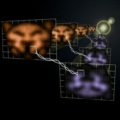
Experiments conducted by researchers at the City of Paris Industrial Physics and Chemistry Higher Educational Institution have shown that it’s possible to focus light through opaque materials and detect objects hidden behind them.
Reporting their findings in Physical Review Letters, the scientists explain that materials such as paper, paint and biological tissue are opaque because the light that passes through them is scattered in complicated and seemingly random ways.
To demonstrate their approach to “decoding” opaqueness, the researchers first passed light through a layer of zinc oxide (a common component of white paints). By studying the way the light beam changed as it encountered the material, they were able to generate a numerical model (called a transmission matrix) that included over 65,000 numbers describing the way that the zinc oxide layer affected the transmission of light.
They could then use the matrix to tailor a beam of light specifically to pass unhindered through the layer and focus on the other side. Alternatively, they could measure light emerging from the opaque material, and use the matrix to assemble an image of an object behind it.
Related:
MIT Created Fiber Web Sees Everything
Tying light in knots
Experiments May Yield Materials With Negative Refractive Index









Comments are closed.